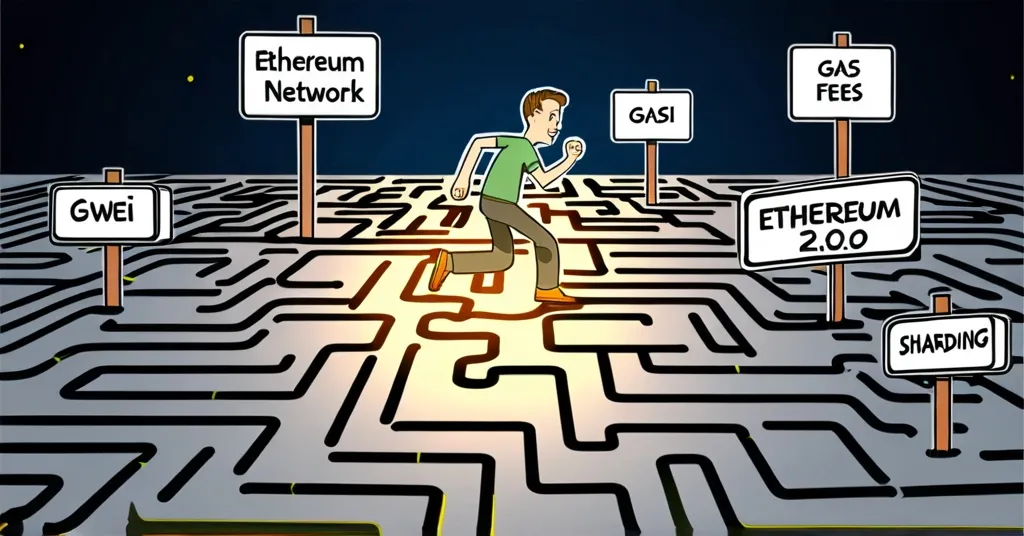Gwei Demystified: Navigating Ethereum Gas Fees and Future Upgrades

Understanding Gwei: The Key to Managing Ethereum Gas Fees
Gwei, a seemingly minute unit of Ethereum, plays a pivotal role in determining the speed and cost of transactions on the Ethereum network. As Ethereum evolves with upgrades like Ethereum 2.0, understanding Gwei becomes increasingly crucial for users looking to navigate the blockchain efficiently and cost-effectively.
- Gwei: A unit of ETH, one billionth of an ETH.
- Transaction fees: Calculated using Gwei.
- Future upgrades: Ethereum 2.0, sharding, and rollups aim to reduce gas fees.
What is Gwei?
Gwei is a unit of Ether (ETH), representing one billionth of an ETH (0.000000001 ETH). It might sound like a weird term, but it’s crucial for Ethereum users. Gwei is widely used to express transaction fees because those costs are typically tiny fractions of ETH. As one seasoned Ethereum user puts it,
Gwei is widely used for Ethereum transaction fees because those costs are typically tiny fractions of ETH.
So, next time you’re about to send some ETH, don’t forget to give a nod to Gwei—it’s the tiny hero behind your transaction. For more detailed information on Gwei, you can visit this wiki.
How Gwei Affects Ethereum Transactions
Gwei directly influences the speed and cost of transactions on Ethereum. If you’ve ever wondered why your transaction took ages to confirm or why the fee seemed exorbitant, Gwei is the culprit—or the savior, depending on how you set it. Higher Gwei fees can lead to faster transaction confirmations, especially during busy periods when demand skyrockets. A blockchain analyst notes,
Higher fees get quicker confirmations, especially during busy periods when demand skyrockets.
So, if you’re in a rush, you might want to bump up your Gwei, but be prepared to pay the price. For more insights on gas fees, check out the discussions on Reddit.
Calculating Gas Fees
Calculating these gas fees involves a bit of math. The total gas fee is calculated as Gas used * (Base fee + Priority fee). The base fee is set by the network, while the priority fee acts as a tip for miners, encouraging them to pick up your transaction faster. Let’s break it down with an example: if a transaction uses 20,000 gas units, with a base fee of 10 Gwei and a priority fee of 2 Gwei, the total fee would be 20,000 * (10 + 2) = 240,000 Gwei, equivalent to 0.00024 ETH. This system can be a bit of a gamble, but it’s designed to keep the network running smoothly. You can find more details on how to estimate gas fees at MetaMask’s support page.
Factors Influencing Gwei Prices
Gwei prices are not static; they fluctuate based on network activity. When everyone and their crypto-loving aunt decides to transact at the same time, Gwei prices can soar. This is particularly noticeable during significant events like network updates or the launch of new decentralized finance (DeFi) projects. It’s like trying to hop on a bus during rush hour—you might have to pay more to get a seat. You can track the current trends in Ethereum network activity and Gwei prices.
The Future of Gwei and Ethereum
Looking ahead, Ethereum’s development roadmap includes changes that could significantly impact how Gwei is used. With the successful transition to Ethereum 2.0, which introduces a more energy-efficient method to validate transactions (Proof of Stake, or PoS), gas fees have become more predictable and efficient, according to a blockchain developer.
With the successful transition to Ethereum 2.0, which introduces Proof of Stake (PoS), gas fees have become more predictable and efficient.
These upgrades promise to make transactions more accessible and affordable. Ethereum 2.0’s shift to PoS is expected to lower gas fees by reducing the computational power needed to validate transactions. Additionally, future upgrades like sharding (a method to split the database to increase transaction capacity) and rollups (a technique to process transactions off the main Ethereum chain to reduce fees) aim to further enhance the user experience by making gas fees more predictable and efficient. For insights into future upgrades and their impact on Gwei, you can explore this resource.
Key Questions and Takeaways
What is Gwei and why is it important for Ethereum users?
Gwei is one billionth of an ETH and is used to express gas fees on the Ethereum network. It is important because it directly influences the speed and cost of transactions, allowing users to manage their expenses and prioritize their transactions effectively.
How does Gwei affect transaction speed and cost on Ethereum?
Gwei impacts transaction speed and cost by allowing users to set higher fees for faster confirmations. During high network activity, setting a higher Gwei amount can ensure quicker transaction processing, although at a higher cost.
How can you calculate Ethereum gas fees in Gwei?
To calculate Ethereum gas fees in Gwei, you multiply the gas used by the sum of the base fee and the priority fee. The base fee is automatically set by the network, and the priority fee acts as a tip to miners for faster processing.
What factors influence Gwei prices on the Ethereum network?
Gwei prices are influenced by the level of activity on the Ethereum network. High demand for transactions can lead to increased Gwei prices, especially during significant events like network updates or the launch of new decentralized finance (DeFi) projects.
What does the future hold for Gwei and Ethereum gas fees?
The future of Gwei and Ethereum gas fees looks promising with Ethereum 2.0 and other scalability upgrades like sharding and rollups. These developments aim to make gas fees more predictable and efficient, potentially lowering costs and improving transaction accessibility.
As Ethereum continues to evolve, the role of Gwei will remain central to the user experience. With ongoing upgrades, the future of Ethereum looks set to revolutionize how we think about and manage transaction fees, making the network more accessible and efficient for everyone.



